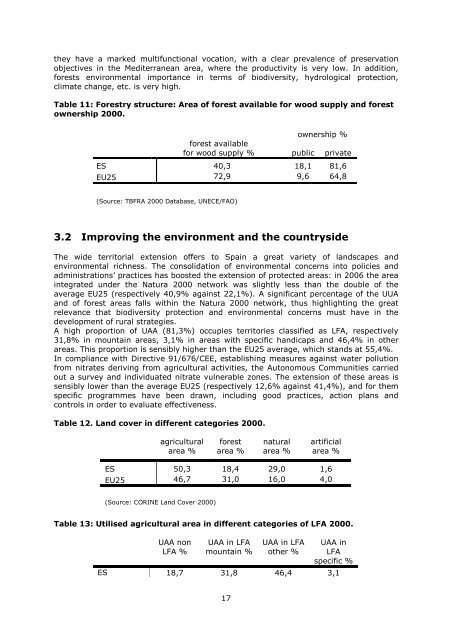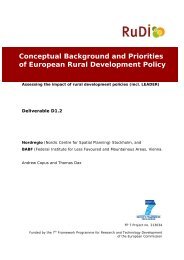Country profile on rural characteristics Spain - RuDI
Country profile on rural characteristics Spain - RuDI
Country profile on rural characteristics Spain - RuDI
- No tags were found...
Create successful ePaper yourself
Turn your PDF publications into a flip-book with our unique Google optimized e-Paper software.
they have a marked multifuncti<strong>on</strong>al vocati<strong>on</strong>, with a clear prevalence of preservati<strong>on</strong>objectives in the Mediterranean area, where the productivity is very low. In additi<strong>on</strong>,forests envir<strong>on</strong>mental importance in terms of biodiversity, hydrological protecti<strong>on</strong>,climate change, etc. is very high.Table 11: Forestry structure: Area of forest available for wood supply and forestownership 2000.ownership %forest availablefor wood supply % public privateES 40,3 18,1 81,6EU25 72,9 9,6 64,8(Source: TBFRA 2000 Database, UNECE/FAO)3.2 Improving the envir<strong>on</strong>ment and the countrysideThe wide territorial extensi<strong>on</strong> offers to <strong>Spain</strong> a great variety of landscapes andenvir<strong>on</strong>mental richness. The c<strong>on</strong>solidati<strong>on</strong> of envir<strong>on</strong>mental c<strong>on</strong>cerns into policies andadministrati<strong>on</strong>s’ practices has boosted the extensi<strong>on</strong> of protected areas: in 2006 the areaintegrated under the Natura 2000 network was slightly less than the double of theaverage EU25 (respectively 40,9% against 22,1%). A significant percentage of the UUAand of forest areas falls within the Natura 2000 network, thus highlighting the greatrelevance that biodiversity protecti<strong>on</strong> and envir<strong>on</strong>mental c<strong>on</strong>cerns must have in thedevelopment of <strong>rural</strong> strategies.A high proporti<strong>on</strong> of UAA (81,3%) occupies territories classified as LFA, respectively31,8% in mountain areas, 3,1% in areas with specific handicaps and 46,4% in otherareas. This proporti<strong>on</strong> is sensibly higher than the EU25 average, which stands at 55,4%.In compliance with Directive 91/676/CEE, establishing measures against water polluti<strong>on</strong>from nitrates deriving from agricultural activities, the Aut<strong>on</strong>omous Communities carriedout a survey and individuated nitrate vulnerable z<strong>on</strong>es. The extensi<strong>on</strong> of these areas issensibly lower than the average EU25 (respectively 12,6% against 41,4%), and for themspecific programmes have been drawn, including good practices, acti<strong>on</strong> plans andc<strong>on</strong>trols in order to evaluate effectiveness.Table 12. Land cover in different categories 2000.agriculturalarea %forestarea %naturalarea %artificialarea %ES 50,3 18,4 29,0 1,6EU25 46,7 31,0 16,0 4,0(Source: CORINE Land Cover 2000)Table 13: Utilised agricultural area in different categories of LFA 2000.UAA n<strong>on</strong>LFA %UAA in LFAmountain %UAA in LFAother %UAA inLFAspecific %ES 18,7 31,8 46,4 3,117



